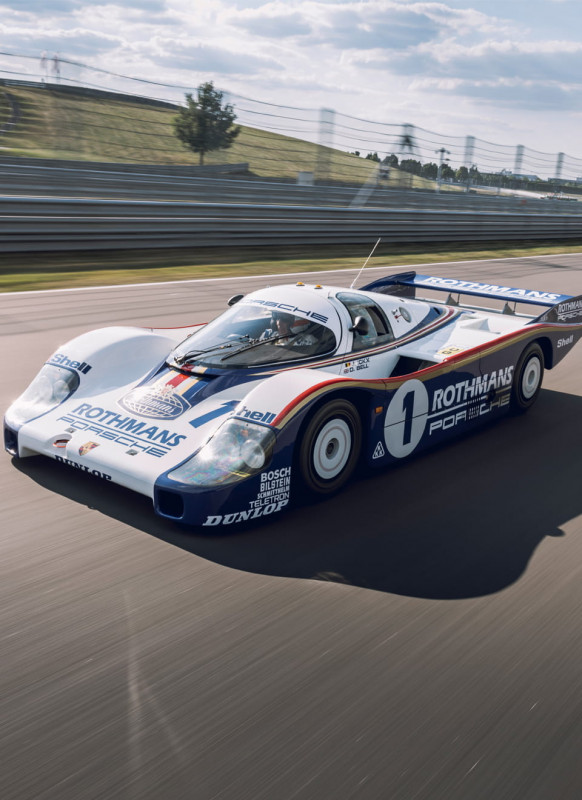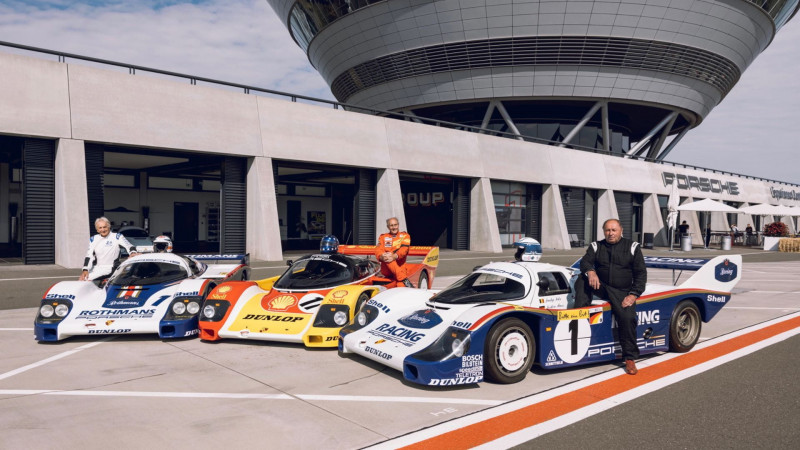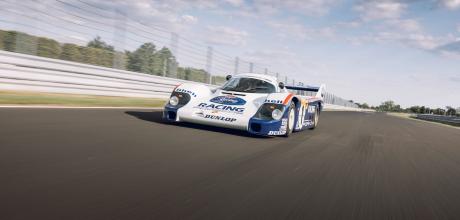1983 WSCC 40 years on, drivers and engineers remember the dominant Porsche 956
In 1983, Porsche 956s performed the unprecedented feat of winning every single round of the World Sports Car Championship. Forty years on, drivers and engineers recall the dawn of a Group C titan.
Words SAM DAWSON
Photography PORSCHE
‘GROUP C CARS WERE SCARY, DANGEROUS THINGS’
40 years since it ruled the track, engineers and drivers recall 956 glories

The first few years of Group C were absolutely hideous,’ says five-times Le Mans winner Derek Bell. Brought together at Porsche’s Leipzig test track with a pantheon of drivers and engineers to remember the glory days of the 956, Bell doesn’t sugar-coat the era that brought him fame and fortune. ‘We came here to race, not be development drivers. The new Group C regulations meant we had to drive economically. The engineers put a card in the middle of the steering wheel to remind us of how many laps we could get to a tank – at Le Mans, 11 if you were doing well – but it meant looking down at the wheel at 225mph on the Mulsanne Straight, using the light from the trackside restaurant to see it at night.’ That’s not to say there was anything unappealing about the Porsche 956 itself. ‘In 1983 Helmuth Bott asked me how the 956 compared to the Can-Am 917 I’d driven for him in the Seventies,’ Bell continues. ‘On test at Weissach, it was a full two seconds faster. The 917 had absolutely no chance of matching the 956. I loved it. Back in 1981 I didn’t even know what Group C was, what the implications of the new regulations meant. But this combination of construction, ground effect and horizontally opposed engine had never been tried before. But Porsche had never been wrong before, so I signed the contract.

‘There was no more tube-frame – the 956 was an aluminium monocoque, a decision taken at the start of the development project. The monocoque was much safer and stiffer.’ Bell’s 1983 Rothmans Porsche team-mate Jochen Mass injects a note of caution. ‘The aluminium monocoques got softer with mileage,’ he says. ‘There were moments of jealousy within the team ahead of the races in 1983, where you knew certain 956s could prove a handicap on certain circuits. But that softness makes an aluminium monocoque far more comfortable to drive. Carbonfibre is harder; when it became the norm you needed more than two drivers per car for a long-distance race.’
Carbonfibre was certainly under consideration for the 956 even as early as 1983, as engineer Norbert Singer confirms. ‘Back in 1982 I had this idea to build the 956 like a Formula One car, with a carbonfibre monocoque, but it wasn’t a viable project for what was a small engineering team at the time, so the idea stopped. But models of that design exist. Even as late as 1988 carbonfibre wasn’t trusted in a sports prototype, but in 1983 the technology simply wasn’t there – and you could see it in the horrific results of F1 accidents at the time.’
There was another element that would make the 1983 World Sports Car Championship even more competitive, as Bell explains. ‘The 956’s predecessor, the Group 6 936, wasn’t sold commercially, because it was a stop-gap between the 917 and the new era of Group C. The rules kept changing in the Seventies – often, as ever, to try and get more manufacturers to build F1 engines. Then in the late Seventies the sports-racing scene was dominated by Group 5 Special Production silhouette cars, which weren’t true sports prototypes in my view. These new Group C rules brought clarity and allowed Porsche to respond properly – and in the 956, create a car it could sell commercially.’
Engineer Helmut Schmid explains Porsche’s commercial strategy for 1983. ‘The decision was made during the 1982 season to have two privateer teams competing alongside the works squad by the time the 1983 Silverstone 1000km came around,’ he says. ‘Norbert Singer made the decision, but by early 1983 the privateers were ready from the start. The cars had been sold and from that point the teams did their own developments, totally beyond Porsche’s control – although we did keep an eye on it to see what worked. For example, British teams tended to add extra winglets and alter the rear-end shape, but at Porsche we felt we were doing the best with our own programme of windtunnel testing – although those privateers had wind tunnels too.’
At the opening race of the season at Monza on 10 April, Tiff Needell was the very first of those privateer drivers to race a 956, a Canon-sponsored car for Richard Lloyd Racing. ‘A wheel fell off!’ he laughs as he remembers the race. ‘Rumour had it that the wheelnut torque settings in the owners’ manual were wrong. In a car costing £178,000 in 1983…’
It wasn’t the only challenge Lloyd’s team faced. ‘Only Le Mans bodywork was available,’ Needell continues. ‘The other bodywork options hadn’t been delivered by the time Monza came around, so we had to race with short-tail bodywork, which wasn’t ideal. It was part of the reason why Lloyd later improved on Porsche’s design with his own monocoque, to create the 962GTi. Kremer also did its own chassis later.
‘But the original was hard to improve upon. I remember my first test day, driving the first 956 in England, chassis 106, and reporting on it for Autosport magazine. It’s important to remember that the 956 wasn’t the first Group C car, but it was by far the most advanced. I’d driven the Aston Martin Nimrod and the 956 was science compared to history. The Nimrod had no ground effect and was very heavy; whereas the 956 was the first monocoque sports-prototype. In 1983 I’d just come from single-seaters so these Group C cars were like trucks to me – big, with slow synchromeshed gearchanges rather than a straight-cut Hewland, very heavy steering and restricted visibility.
‘I did a dozen laps in that test session with the 956, then just turned up to Monza and did a dozen more. Jan Lammers had tried to set it up to work at Monza but at that stage everything was very experimental. Then that wheel fell off. However, I could three-wheel the car back to the pits – the monocoque was stiff enough to do that – so we could get it back out again.’ Needell and Lammers eventually brought the car home in sixth.
It would be another privateer 956 – the Joest car driven by Bob Wollek and Thierry Boutsen – that would pip the works 956 of Mass and Jacky Ickx to the post at Monza. Incredibly, the top seven finishers were all 956s. The next-highest-placed Group C car, a works Lancia LC2 driven by Michele Alboreto and Riccardo Patrese, finished ninth – embarrassingly behind an old Group 6 Lancia LC1 run by privateer Scuderia Sivama.
‘The 956 had no credible rivals in 1983,’ says Needell. ‘The Nimrod project ran out of money, Rondeau was still going but only just. You couldn’t buy Steve O’Rourke’s EMKA-Aston Martin, Ford’s C100 project didn’t go anywhere, and the other customer cars from the likes of Lola and March were powered by off-the-shelf Chevrolet V8s or Cosworth turbos. So in 1983, if you wanted to race in Group C you had to either buy a Porsche 956 or make your own car with a British garagiste.’ And the Lancia LC2? ‘Its tyres used to explode,’ Needell says. ‘Lancia was the only car not on crossplies in 1983. They weren’t as quick as radials, but radials made handling very edgy.’
Jochen Mass has a different take on the Lancia. ‘They were quick, but their aerodynamics were less efficient than Porsche’s,’ he says. ‘They were quick on the straights, but lacked downforce in the corners so had to take them slower. But the Lancias were still tough nuts to crack. Overtaking them became an exercise in patience sometimes, waiting for your moment to pass them.’
But as Needell interjects, driving a 956 wasn’t exactly a calming experience either. ‘Group C cars were scary, dangerous things,’ he says. ‘Three F1 drivers were killed in them during the Group C era. Your head sat outside of the roll cage, it wasn’t far from the track to the barriers, and the factory cars ran locked differentials with a spool differential – a miniature mechanical component that locked both wheels on the axle to overcome the limitations of an open diff. But it made it skittish in the wet until Lloyd added a conventional limited-slip differential to his cars.’
The next race, the Silverstone 1000km on 8 May, was a dominant lights-to-flag display for Derek Bell’s works 956, but also a reminder that there is an empty seat at the table today. He shared his car with 25-year-old Stefan Belloff, whose spectacular performances in 1983 set lap records and propelled him into Formula One. In qualifying for the 1983 Nürburgring 1000km at the end of May, one of the last races to be held on the Nordschliefe, the young German set a lap record that would stand for 35 years. However, his performance in the race itself would hint at tragic events to come.
‘During the Nürburgring 1000km, we were leading by a huge amount,’ says Bell. ‘I’d never won there, so I was looking forward to crossing that one off. Belloff was lapping quicker and quicker – impressive speeds. But we needed to conserve the car because it was a long race. I went up to the Porsche VIP box and said, “Why don’t you put a board out telling him to go steady?” and the response was, “But isn’t he brilliant?!” Two laps later, he crashed.’ Mass and Ickx took the win instead.
‘Belloff and I never discussed it, but I always felt I should have had a chat about it,’ says Bell. ‘Gulf manager John Wyer would have said, “You need to calm down a bit, you’ll crash my car”, but no one at Porsche did that. After the Nürburgring, Porsche asked me to partner Belloff at Le Mans and I said no – I wanted to win. ‘As a driver, Belloff was amazing, but he didn’t seem to realise quite where the car’s limits were. And I couldn’t say anything to him because he was my teammate and he was quicker. He called me father, I called him son. But I always felt he wasn’t mature enough to race in Group C. He’d come up through the single-seater formulas too fast and in an uncontrolled way.’
Belloff was killed in an accident following a reckless overtaking manoeuvre on his Porsche teammate, Jacky Ickx, in the 1985 1000km of Spa, but not before his performances in an unfancied Tyrrell F1 car had drawn direct comparisons with fellow rookie Ayrton Senna. ‘I think he could have beaten Senna,’ says Bell today with a heavy heart. ‘He was quick enough, I liked the guy a lot, and I feel someone should have said something to him before it was too late. But they didn’t.’
Jochen Mass plays down comparisons between Belloff and Senna. ‘He was very quick, but his undoing was his recklessness. ‘In Group C you couldn’t just push other cars out of the way; you had to be respectful. But I don’t like to speculate as to what he might have achieved if he had lived. Why make someone larger than life before he can prove it? Senna had that chance. Every year has its fastest drivers. Senna and Belloff were inspiring but so was Jackie Stewart. I find it unnecessary, almost silly, to attach the label of greatness whenever a rivalry appears in motor sport.’ Given Porsche’s astonishing win rate, the world title could be clinched with a win at Le Mans, but this was always easier said than done – especially when Michele Alboreto unexpectedly put his Lancia LC2 second on the grid in qualifying.
And the race itself was tortuous. ‘I had to take the body off and put it back on myself during that race,’ says Derek Bell, who got his way and partnered Ickx for Le Mans. ‘Ickx was hit by Lammers’ Richard Lloyd 956 going into Mulsanne on the first lap, and couldn’t get back on track, so had to wait for all the other cars to go past. So we started the race in last place by a lap. ‘At the 14th hour, having clawed our way back to take first, the engine just stopped. According to the rules, if a car stops on track at Le Mans the mechanics can’t come to help but the driver can fix it. Norbert Singer had talked all the drivers through some scenarios the day before, and said that if the engine suddenly cuts out it could be one of four or five things.
‘But I had to get out of the car and get the rear clamshell off myself, undo some pipework and rest its front end on the rear tyres. I changed a sensor on the flywheel, and a cockpit electronics module, got back in, turned the key and the car started again. I put the bodywork back on, drove back to the pits without putting my seatbelt on and handed it over to Jacky. ‘Then when we got back into the lead, a crack developed in the elbow-joint on the oil cooler hosing, and the car started leaking oil. Schuppan’s teammate Al Holbert got in front of us during a three-minute fuel stop. At 1.30pm I got out, and was resting in my motorhome when there was a knock on the door, with someone shouting, “Ickx in, 10 minutes!”
‘I have a reputation for being able to bring a car home safe. When I got to the pits Norbert Singer said there was a problem with the brakes; the discs were cracked. We were a lap behind and changing the discs would take four minutes. Option two was for me to take over, go slowly, and engine-brake for the last two and a half hours.’ Soon after Bell rejoined the fray, the works 956 of Mass and Belloff succumbed to engine failure just two hours from the chequered flag. ‘I drove as fast as I could to warm up the discs on the straights, thinking the heat could glue the cracks up,’ says Bell. ‘I set two lap records in the last hour. That was the hardest race of my life. But Le Mans always forces you to drive beyond your abilities.’ Bell finished second, behind the works 956 of Vern Schuppan, Al Holbert and Hurley Heywood.
Needell brought the EMKA-Aston Martin home in a creditable 17th place. ‘That race, and the ’83 championship, was a walkover by the 956,’ he says. ‘The immediate response by all the teams was one of jealousy – “I want one of those!” – and then Joest, Richard Lloyd, John Fitzpatrick did just that, taking on the factory team and winning. By 1985 the works cars were seven laps off the pace at Le Mans.’
But that didn’t matter. In winning every race in 1983, the Porsche 956 had already defined Group C.
‘I had to take the body off and put it back on myself during the 1983 Le Mans 24 Hours’ DEREK BELL
Today at Leipzig – the 956 is a terrifying drive from a lost era Nürburgring, 1983: Mass/Ickx 956 ticks itself cool after win.
The Ickx/Mass car headed for win – Belloff crashed out Engine failures due to ‘one of four or five things,’ says Bell.
Peter Falk (right) supervises pit stop at Nürburgring, 1983.
‘The immediate response by all the teams was jealousy: “I want one of those!”’ TIFF NEEDELL
‘The 956 wasn’t the first Group C car, but it was by far the most advanced.’
‘I had the idea to build the 956 like an F1 car, but carbonfibre tech wasn’t trusted in 1983’ NORBERT SINGER
‘The Lancias were tough nuts to crack. Overtaking became an exercise in patience’ JOCHEN MASS [right of pic, with Derek Bell]
Monza, 1983: works 956s prepare to face privateer challenge Nürburgring, 1983: Stefan Belloff (car 2) set record lap in qualifying Spa, 1983: Porsche 956s en route to a five-car clean sweep.
Weissach, 1983: the first batch of privateer 956s.
Porsche engineers pose with the 956 pre-’83 season. Norbert Singer (centre) holds court with Jacky Ickx.
Le Mans, 1983: the works 956s line up before the start


